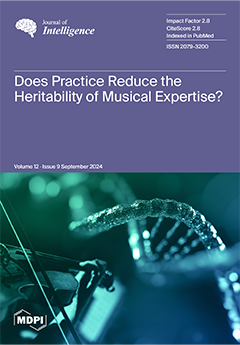Examining the relationship between self-assessed intelligence (SAI) and psychometric intelligence (IQ) is essential for understanding how people’s self-evaluations reflect their actual intelligence. Various factors, such as SAI measurement methods, participant characteristics, and testing conditions have been hypothesized to moderate the SAI–IQ link, yet
[...] Read more.
Examining the relationship between self-assessed intelligence (SAI) and psychometric intelligence (IQ) is essential for understanding how people’s self-evaluations reflect their actual intelligence. Various factors, such as SAI measurement methods, participant characteristics, and testing conditions have been hypothesized to moderate the SAI–IQ link, yet the generality of this association remains unclear. Here, we provide evidence for SAI and IQ associations based on 278 effect sizes from 115 independent samples (
N = 36,833) using a multi-level meta-analysis, revealing a moderate positive correlation (
r = 0.30; 95% CI [0.27, 0.33]). Multiverse analyses demonstrated remarkable stability of this effect, with most summary effect specifications yielding significant positive correlations (96%), averaging
r = 0.32. Notably, ability domain and sample type emerged as significant moderators, with numerical ability showing stronger correlations compared to general cognitive, verbal, and spatial abilities. Importantly, our study found that correlations in student samples were significantly higher than those in general samples. Our findings show a moderate positive association of SAI with IQ, unaffected by participant sex, publication year, administration order, neuroticism, and self-assessment method, yet significantly moderated by ability domain and sample type. Our results illustrate the importance of feedback in educational settings to help students accurately assess their cognitive abilities.
Full article






